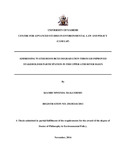| dc.description.abstract | The rating of Kenya as a water scarce nation and the projection that the situation is expected to deteriorate further makes the need for sustainable water resources management critical. With the reality of scarcity, it is desirable that all stakeholders make choices and decisions that converge with requirements for sustainable development. Their individual and collective actions in use and management of water resources should reflect adherence to the principles of sustainable development.Whilst the Constitution of Kenya 2010; the ―Water Act 2002‖; ―The Water Act 2016‖; EMCA 2000; EMCA (Ammendment) Act 2015 the ―National policy on water resource management‖ (GOK, 1999); ―The draft National Water Policy‖, (GOK, 2012) and ―the National Policy on Environment‖, (GOK, 2014) uphold the need for sustainable management and anchor public participation, water resources continue to be degraded.
This study aimed to assess the drivers, pressures and impacts of water resource degradation in Upper Athi River Basin; the existing policies, laws and institutions that guide stakeholder participation in water resources management; and examine the factors that influence stakeholders‘ participation in addressing water resource management. Stakeholders‘ responses to policy interventions for abating degradation of water resources have also been analyzed with a view to identifying remedies for enhancing co-operation in the sustainable use and management of water resources in upper Athi River basin. The study was guided by the subsidiarity principle anchored under social theory and game theory.
This study combined both primary and secondary data. Primary data were obtained from interviews conducted on key informants and members of WRUAs and CAACs. The data was assigned values obtained from the operational definition of the variables. These included social
economic and participation variables. Secondary data on sustainable development concept; IWRM principles; drivers and responses to degradation; stakeholders‘ participation; water resource management policies; laws and institutional arrangements for stakeholders participation was obtained from research articles, books, legal publications, journals and reports on water resources management and environmental management.
DPSIR framework was employed to assess drivers of and responses to degradation in upper Athi River basin. WRUAs and CAACs (now BAWRCs) are identified as mechanisms for stakeholders‘ participation in water resources management in Upper Athi River basin. The factors influencing the participation of members of WRUAs and CAACs were examined through logit regression analysis of their responses in terms of relevance of information, representation, transparency, access to information and accountability. Stakeholders (Water users) responses to fines, licenses and incentives as policy interventions for ensuring collective action to address the problem of degradation are simulated using game theory based prisoners dilemma model. The results are presented in form of graphs and frequency tables; payoff functions with explanatory narratives.
The findings reveal that the main drivers of water resources degradation in upper Athi river basin comprise; increased industrial, commercial, residential and agricultural developments. The needs of these developments are the main sources of pressure on water resources in upper Athi river basin. The water resources in upper Athi river basin reflect a state of heavy degradation. This degradation inhibits the ability to supply water to drive economic activities, preserve biodiversity and sustain livelihoods. participation in water resources management is significantly influenced by inclusivity, information relevance, income and education levels of members of WRUAs; Kenya‘s responses for addressing water resource degradation are mainly of command and control nature,
while leaving out economic instruments; Technological measures and changing of social norms. Responses of water users indicate that fines, waste disposal licenses and incentives are effective tools for abating water resource degradation.
The study concludes that water resources in upper Athi River basin continue to be degraded despite there being legal and policy frameworks that anchor IWRM and sustainable management. WRUAs and CAACs (BAWRCs) offer important public participation platforms but need to be strengthened; Voluntary stakeholder participation is a key ingredient of sustainable water resources management, though it is not sufficient in resolving water resource degradation problems. Other responses that coerce or create incentives for stakeholder participation beyond command and control measures should be employed to achieve effective collective action. These responses include Fines, Licenses and incentives. They should be anchored in policy and law. Their application should be aligned to stakeholders‘ behavioral simulations that balance economic interests and environmental management concerns. | en_US |

